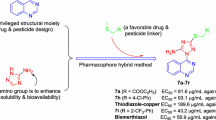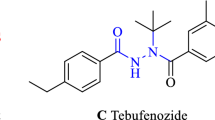Abstract
Fungicidal activity against phytopathogenic fungi of diarylthiazole compound of N-[4-(4-fluoro) phenyl-2-(N-methyl)piperidin-4-yl-thiazol-5-yl]pyrimidin-2-yl-N-(3-hydroxy-methyl)phenylamine (I) have been determined to be a superior and compound I was used as the leading compounds in this study. Furthermore, the synthesis of this compound was conducted by reacting them with four functional groups, N-cyclopropyl, N-cyclopentyl, N-cyclohexyl, and N-isopropylamine instead of the phenylamine. Also, 2-aminothiazole, 2-(N-ethoxycarbonyl)piperidin-4-yl, and 2-piperidin-4-ylthiazole were introduced as the leads instead of the 2-aminothiazole group of compound I. From this scheme, VIII-1∼VIII-4 and XII-1∼XIV-4 compounds were newly synthesized and their structures were confirmed by 1H-NMR-spectrum. The fungicidal activities of all the synthesized compounds against Phytophthora capsici were examined using the whole plant method. While the EC50 value of the commercial fungicide dimethomorph and I was 4.26 mM and that of N-[4-(4-fluoro phenyl-2-(N-methyl)piperidin-4-yl-thiazol-5-yl]pyrimidin-2-yl-cyclopropylamine (XIV-2) on P. capsici was 0.84 mM. Among the XII-1∼XIV-4 chemicals, XIV-2 showed the most potential antifungal activity in vivo. Therefore, XIV-2 can be considered as a viable candidate for the control of phytopathogenic diseases characterized by P. capsici infection, and further studies will be conducted on the mode of action XIV-2.
Similar content being viewed by others
References
Black LL, Green SK, Hartman GL, and Poulos JM (1991) Phytophthora blight. In Pepper Disease: A Field Guide, pp. 1–50, Asian Vegetable Research and Development Center, Taipei, Taiwan.
Choi WS, Nam SW, Ahn EK, Park BS, Lee SE, Kim TJ, and Choi IY (2010) Synthesis and fungicidal activity of N-[4-(4-fluoro)phenyl-2-piperidin-4-yl-thiazol-5-yl] pyrimidin-2-yl-N-phenylamines on Phytophthora capsici. J Korean Soc Appl Biol Chem 53, 206–214.
Coulomb C, Lorient R, and Coulomb J (1985) Etude ultrastructurale et cytochimique d’un champignon pathogene, le Phytophthora capsici, au cours de l’infection de feuilles de Piment de variete sensible. Mise en evidence d’un systeme phytolysosomal actif. Ann Sci Nat 7, 23–38.
Durand MC and Salle G (1981) Effet du tris-o-ethyl phosphonate d’aluminium sur le couple Lycopersicumesculentum Mill-Phytophthora capsici Leon. Etude cytologique Agronomie 9, 723–732.
Grangeon MJ and Coulomb J (1997) Etude de l’interaction hote-parasite sur le couple Capsicum annuum-Phytophthora capsici. C R Acad Sci Paris 285, 167–170.
Granke LL, Windstam ST, Hoch HC, Smart CD, and Hausbeck MK (2009) Dispersal and movement mechanisms of Phytophthora capsici sporangia. Phytopathology 99, 1258–1264.
Hodges CF, Campbell DA, and Christians (1993) Evaluation of Streptomyces for biocontrol of Bipolaris sorokiniana and Sclerotinia homeocarpa on the phylloplane of Poa pratensis. J Phytopathol 139, 103–109.
Huang JX, Jia YM, Liang XM, Zho WJ, Zhang JJ, Dong YH, Yuan HZ, Qi SH, Wu JP, Chen FH, and Wang DQ (2007) Synthesis and fungicidal activity of macrolactams and macrolactones with an oxime ether side chain. J Agric Food Chem 55, 10857–10863.
Hurtado-Gozales O, Aragon-Caballero L, Apaza-Tapia W, Donahoo R, and Lamour K (2008) Survival and spread of Phytophthora capsici in coastal Peru. Phytopathology 98, 688–694.
James TP, Clifford Bryant, Wang DX, Dana ED, Eduardo L. S, Robert MR, Shankar V, Tian ZQ, Leland CB, Rohan VM, Eric S, John M, Tobee C, Harry C, James W. J, Mary M, John RS, Philip Enriquez, Yu ZW, Robert MS,Liu L, Michael CV, M. David P, Jean-Pierre F, Peppi P, Renata O, Denis R, Robert NY, Gregg W, Sevgi BR, Colena J, Donald BK, and Gideon R (2005) Design and synthesis of tri-ring P3 benzamide-containing aminonitriles as potent, selective, orally effective inhibitors of cathepsin K. J Med Chem 48, 7520–7534.
Kenneth CR, James RH, John HD, Scott AW, Druie EC, Gilbert CO, Bohumila F, and John JS (2003) Imidazopyrimidines, potent inhibitors of p38 MAP kinase. Bioorg Med Chem Lett 13, 347–350.
Kim DS, Chun SJ, Jeon JJ, Lee SW, and Joe GH (2004) Synthesis and fungicidal activity of ethaboxam against Oomycetes. Pest Manag Sci 60, 1007–1012.
Lamour KH and Hausbeck MK (2002) The spatiotemporal genetic structure of P. capsici in Michigan and implications for disease management. Phytopathology 92, 681–684.
Laszlo R, Ernst B, Franco EP, Thomas B, Roland F, Hermann G, Peter H, Ute M, and Gerard R (2004) Novel p38 inhibitors with potent oral efficacy in several models of rheumatoid arthritis. Bioorg Med Chem Lett 14, 3595–3599.
Lee HS, Lee SW, Cho KY, Kim MK, and Ahn YJ (2001) Fungicidal activities of 51 fruit extracts against six phytopathogenic fungi. Agric Chem Biotechnol 44, 147–153.
Li XH, Yang XL, Ling Y, Fan ZJ, Liang XM, Wang DQ, Chen FH, and Li ZM (2005) Synthesis and fungicidal activity of novel 2-oxocycloalkylsulfonylureas. J Agric Food Chem 53, 2202–2206.
Rajkumar M, Lee WH, and Lee KJ (2005) Screening of bacterial antagonists for biological control of Phytophthora blight of pepper. J Basic Microbiol 45, 55–63.
Ristaino JB (1991) Influence of rainfall, drip irrigation, and inoculum density on the development of Phytophthora root and crown rot epidemics and yield in bell pepper. Phytopathology 81, 922–929.
Sujkowski LS, Parra GR, Gumpertz ML, and Ristaino JB (2000) Temporal dynamics of phytophthora blight on bell pepper in relation to the mechanisms of dispersal of primary inoculum of Phytophthora capsici in soil. Phytopathology 90, 148–156.
Xu X, Qian X, Li Z, Song G, and Chen W (2004) Synthesis and fungicidal activity of fluorine-containing phenyliminothiazolidines derivatives. J Fluorine Chem 125, 1159–1162.
Zhou T and Boland (1998) Suppression of dollar spot by hypovirulent isolates of Sclerotinia homeocara. Phytopathol 88, 788–794.
Author information
Authors and Affiliations
Corresponding author
Rights and permissions
About this article
Cite this article
Nam, SW., Choi, IY. & Choi, WS. Synthesis and Antifungal Activity of 5-[2-(Alkylamino)pyrimidin-4-yl]-4-phenylthiazol-2-cycloalkylamine Derivatives on Phytophthora capsici . J. Korean Soc. Appl. Biol. Chem. 54, 395–402 (2011). https://doi.org/10.3839/jksabc.2011.062
Received:
Accepted:
Issue Date:
DOI: https://doi.org/10.3839/jksabc.2011.062




